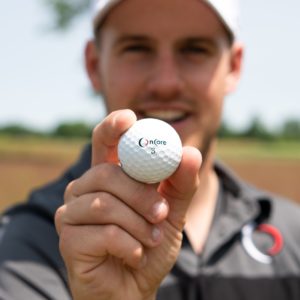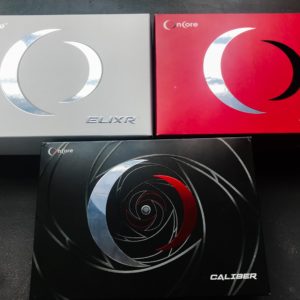We bumped into a few golfers on New Year’s Day. They smiled at us, in that happy but uncertain way of someone blending optimism with uncertainty. We sat down for a spell, and learned the motivation for their awkward balance of emotions: they wanted to play better golf this year, were happy with their clubs and apparel, and looked to the myriad golf ball options with nearly-complete confusion. We nodded, and agreed that the diverse core, cover, price, and performance options of golf ball selection in the new decade were well-capable of confusing even the seasoned golfer. With that in mind, we decided to craft a long-form piece on how to purchase a golf ball in the year 2020. Trust us, there’s a happy ending to this tale.
An appropriate place to begin our investigation is a look at the anatomy of the golf ball. There have been, since the game was first played, three aspects of the diminutive orb that merit attention: the core, the cover, and the cover’s dimples. The inside of the golf ball has, at times, consisted of feathers, rubber bands and a liquid center, and these days, a sexy chemical compound known as polybutadiene. The cover has traversed leather; a hardened, rubbery goo called gutta-percha, surlyn, balata, and these days, urethane. (Balata and gutta percha are actually the same material except balata is now synthetic, a more processed material and then vulcanized. Gutta percha could be warmed and reformed in a mold whereas balata is thermoset by heat)
One of the great, romantic stories of golf’s lore, is the epiphany moment of the original player, upon discovering that nicked balls gained height and distance. It turned out that those fresh, smooth covers didn’t handle air as well as a scuffed one. The more scars, the better the upspin. Early golfers took to scratching their spheres, the way a pitcher works a baseball. In the 20th century, cover patterns took a sizable leap forward, as a variety of geometric configurations and dimple depths and widths were tested, in search of the most efficient one.
Anatomy of a golf ball
The golf ball consists of the core and the cover, with an addendum to cover, for dimple pattern. That’s it. Yet somehow, nearly every major manufacturer finds a way to build 8 to 10 golf ball models. Is it that complicated? Maybe, but maybe not. Let’s have a look at how the golf ball breaks down.
Two of the first three golf ball forms were single-construction orbs. Before the feathery, there were wood golf balls; after the feathery came the gutta-percha ball. Both wood and the gutty were one-piece items. Certainly more economical than those that required assembly, but each gave way to something better. In the case of the wood ball, it was the leather pouch that was stuffed with boiled feathers. As much a luxury item as a functional ball, the feathery itself was then eclipsed by the first, rubbery ball, the gutty. Around the turn of the 19th to 20th centuries, the first modern ball came along: the Haskell. It combined the best of the gutty (the cover) with new and high-tech guts. Just like that, the golf ball industry entered a new era, from which it has yet to leave.
Today, the typical golf ball possesses a center core made of polybutadiene rubber and other chemicals. Some balls leave it at that, moving directly to a single-layer cover. Other golf balls, especially the higher-end ones, layer mantles of ionomeric resins between the center and the cover. 2- and 3-layer ball are made and played, from the elite professional, to the weekend chop. If you’re geeked out on golf ball cores, you’ll toss around terms like dual cores, gradational hardness, and muscle-fiber with aplomb. Whom does the multi-layer, or single-layer core benefit most? That’s where things get complicated and controversial.
Moving to the cover, then, after the leather and the gutta-percha of the first 100 years, manufacturers moved toward balata (for feel) and surlyn (for durability.) In the 1990s, companies inserted polyurethane into the mix, forever complicating the layman’s understanding. So, why did balata go away, yet Surlyn stuck around? Balata was replaced by something unexpected: soft and durable, with more diverse options. That’s cast urethane. Surlyn continues to be less expensive than either urethane or balata, really durable, and longer off the clubface. Its only drawback is its firmness; the top feel players aren’t interested.
What’s left to explore, are the dimples. Those initial, accidental nicks in the featheries and guttys, are now as targeted and intentional as science can make them. Dimple numbers range from 300 to 400 per ball. A few models head north of 400 dimples; they are distance models, and we suspect that they hope to have their purchasers equate number of dimples with distance, as they roar for greater yardage gains. Depending on the research team you interview, however, you’ll find that smaller dimples, larger dimples, deeper and shallower ones, all impact the flight of a golf ball. After the size of the dent, we must consider the arrangement of the scoops. Can you say tetrahedral catenary three times fast, while spinning and holding your breath? Probably not, but it’s not really important.
In the words of John Calabria, senior technical adviser at OnCore Golf, “Paint is a critical component of a golf ball. Typically golf balls are painted with two or three coats. Surlyn balls get two coats of clear while urethane balls typically get three coats, two white and one clear. The main goal for applying paint is to keep the ball clean and shiny. However, the thickness of all the coats of paint must be considered when designing the dimple pattern. The dimple pattern is made to accept a certain amount of paint. If the paint is applied too heavily it will shallow out the dimples and make the ball fly higher then desired. If the paint is too thin the surface of the ball will not look good and it will not retain its shine. This will also affect the flight of the ball but typically manufacturers take steps to reject balls with paint defects like these.
Another interesting point is the paint must be flexible enough to move with the expansion and contraction of the ball when hit. If the paint were stiff it would crack and flake off under the stress of being hit with a driver. Much like the paint on a car it has to move with changes in temperature, vibration and when hitting another object or the grooves of an iron.”
What is important, is how a golf ball manufacturer balances lift, drag, and spin. Spacing between dimples, arrangement of small and wide, deep and shallow dimples, varies from ball to ball, within one manufacturer’s roster of shells. Since they are in the public domain and free to imitate, most arrangements are known to every company, large or small.
Construction of a golf ball
We’ve made inroads into our next topic, but it’s worth a section of its own, to put a bit of a dispute to rest. We’d like you to keep in mind the children’s tale about the Princess and the Pea, when digesting what we are about to tell you. That wag at your office water cooler, or the one that hangs around the locker or grill room, espousing the benefits of 2-piece ball, vs. 3-piece pill vs. 4-piece marble, might be a princess or a pea. We’ve run into a decent sample size of golfer, who can distinguish between the 2-piece ball and the others. The reason might be, that the majority of 2-piece balls have a Surlyn cover. Most 3- and 4-piece balls offer a urethane cover. If one were to swap out the covers, golfers might be revealed as selecting via cover, rather than the number of sub-cover layers. Although there is no doubting the engineering that goes into multi-layer golf balls, keep in mind that companies are targeting wanna-be pros, those who need to have tour-utilized equipment in their bag at all times. The vehicle (and truthfully, the golfers who gain the most benefit) are the touring professionals themselves. Our advice is to find a golfer (probably on the LPGA Tour) with your swing speed, and find out what layer golf ball she or he has in play.
Price
Guess why direct-to-consumer balls cost a bit less than traditional, sales-channel golf balls? You guessed it: the middle ground. Everyone involved along the sales chain, receives a cut of the action. If a ball is sold in an on-course shop, an off-course store, or a big box, the venue adds a bit to your cost. In contrast, the direct-to-consumer option, made obvious and easy by the internet, eliminates all middle operators, and strips those added revenue slices from the consumer’s cost.
It is true that shipping comes into play, but many of the DTC companies offer value-added sales throughout the year, so the cost of shipping is wiped away by the decrease in price/increase in quantity. Will the big names in golf balls, the ones that have been around for decades, the ones that buy up hours of advertising space during golf programming, ever go to a DTC business model? They might, but until they do, expect to pay premium price for their spheres.
Performance
The best questionnaire you’ll ever answer, if you’re honest with yourself, is the one that inquires about what matters most to you. Not what matters most to your long-hitting friend, nor what matters most to your plus-handicap neighbor. You can’t influence them, and they can’t impact you.
The next time you practice or play, ask yourself what sensation is of critical importance to you. Is the feel of a golf ball supreme in your estimation? When you absolutely have to find the fairway, or chip it close, do you feel, rather than think about, the ball and shot? Or, are you the marauder who needs to obliterate the little white pill, compressing and punishing it, launching it skyward, seeking out every possible yard you can acquire?
Close to feel, but not exactly the same, is accuracy. None of us likes side spin much, unless we need to slide the ball around the bend, in search of eagle! Current technology allows inventors and engineers to reduce side spin of a golf ball, so that our fades and draws remain just that, and don’t disintegrate into hooks and slices.
Finally, the two-faced term known as compression, deserves a bit of attention. The firmness of the ball, what we often refer to as its compression, allows golfers to compress the ball’s core, creating the spring effect that repels the ball toward the target. It reasons that, the faster the swing speed, the greater degree to which the ball is compressed.
Let’s paint a portrait of two golfers, and you can determine which one you are, or wish to be. Both golfers are medium-pace swingers, with a bit of outside in to the downswing. The first one recognizes the speed and path of the swing, and purchases a golf ball that fits her/his swing ideally. The second one loves marketing, pipe-dreams of being a tour pro, and purchases the firmest ball used by the fastest swinger on the you-name-it tour. Sound familiar? We’ll ask one more question: which of the two enjoys the game more, and gets more out of her/his rounds and practice sessions?
Fitting
A long-time, golf industry source and member of OnCore’s golf ball development team offers the following insights:
“The most important thing a serious golfer can do is spend time finding the right golf ball to maximize their scoring opportunities. Scoring happens from 160 yards and in to the green. Hitting and holding a green from 160 yards; throwing a high, straight ball at the pin from 115 yards and have it stay within 2 yards of the ball mark; hitting a low runner that checks after 15 yards from just off the collar are all dependent on the golf ball. Knowing what shots you want to play as a golfer and trusting your golf ball to deliver in these situations translates to lower scores and happier rounds of golf.”
How many golfers do you know, who simply want long? It’s as if the game were defined by one shot, and the collective others didn’t matter. No question, the long ball is fun and memorable, but more than the shot that spins and stops, close to the hole? Not for most of us, it isn’t.
“I start every golf ball fitting discussion asking how the golfer wants to play around the green and then work backwards. Distance is a great thing but missing a green from 30 yards away or leaving yourself a 50 foot putt because you can’t control your ball placement cost far more strokes than an extra 10 yards of distance off the tee. So, ask yourself – do I want to throw the ball at the pin with a high trajectory and have it hold close to its ball mark? If so, this requires a ball with a relatively soft cover and low spin. Do I want more finesse around the green where I pinch the ball with a low shot that checks up? If so, this requires a soft cover and more overall spin.”
Poll the golfers in your group, on any given Saturday, and the odds are low that they’ve thought about the height of the shot with which they wish to approach the green. Sure, they’ve hit high, medium, and low approach shots, but have they considered which worked best, then taken steps to consistently repeat that feature? We both know the answer. But this isn’t about them; it’s about you!
“Once I determine how I like to play around the greens we start to work backwards to how you like to play your approach shots. Do you prefer to shoot straight at your target with a high trajectory or do you want to have the ability to work the ball’s trajectory as well as work the ball left to right? These differences require different ball characteristics.”
We all have a direction and a preferred side on which to miss. Again, it’s about consistency and, ideally, minimizing the sideways movement of an approach shot. The collaboration of golf ball fitting and lessons can not be understated, but if there’s neither time nor money for lessons, the golf-ball fitting takes on greater importance.
“Finally I get to the tee. Truthfully distance off the tee should be the last criteria when choosing a ball. The best course of action is to find your preferred ball around the green and in the fairway and then fit your driver to maximize distance off the tee. For example, if you like more spin, control and workability around the green and mid irons your golf ball is going to have a very soft cover and a high spin rate. These things translate to poor distance off the tee. To minimize the distance penalty I would recommend a driver with a little lower launch angle and a shaft combination that reduces driver spin. This will maximize your distance off the tee while still allowing you to score how you want to play in and around the greens.”
And with that, friends, we conclude this long-form piece on how to research and buy a golf ball, in the year 2020. These words should stand the test of time and, if you take the proper steps to find the proper ball, so too, will your game. Great success to you on the course this year, and for many years to come.
+++
EXPLORE ONCORE GOLF
Check out OnCore’s Award-Winning Golf Balls:
One of the best golf balls on the market, taking Gold in the 2019 Golf Digest Hot List, and the most advanced golf ball to date.
OnCore’s award-winning, super soft, low compression (55) distance golf ball. Featuring low spin rates off the driver for long and accurate tee shots.
SOCIAL LINKS







